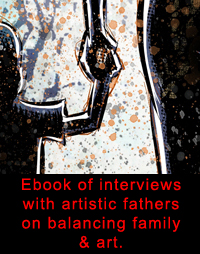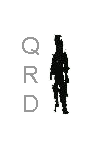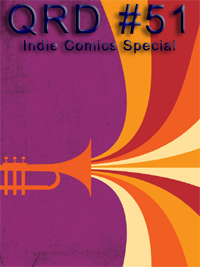
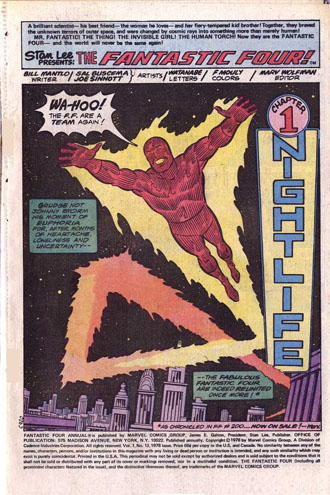
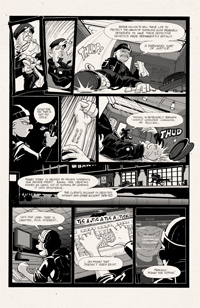
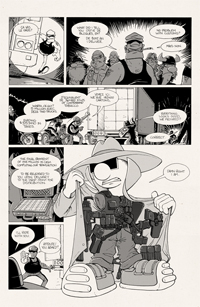
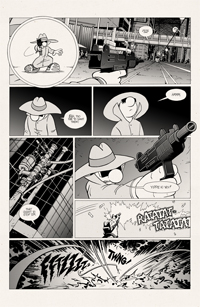
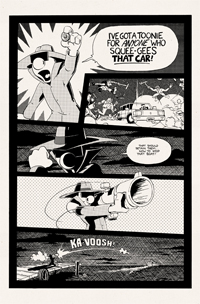
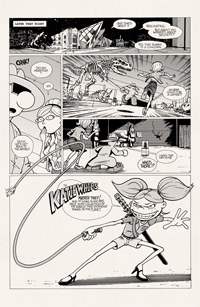
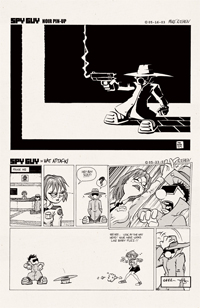
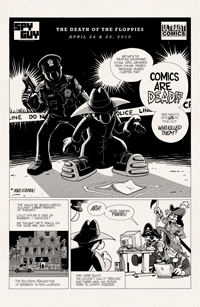
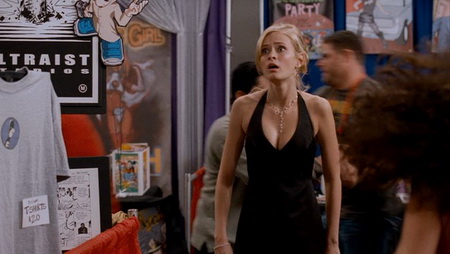


June 2011
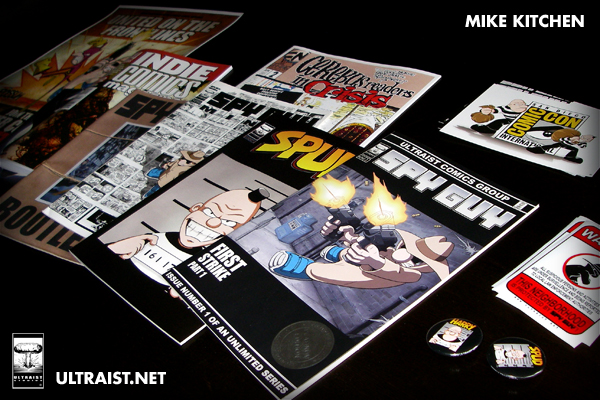
City: Toronto, Ontario, Canada
Comics: Spy Guy
Websites: www.ultraist.net
QRD – How old were you when you first got into comics & did you always stick with them or did you come back to them?
Mike – As young as I can remember I have always been reading comics. There was a box full of my uncle’s silver age comic books at my grandparents’ cottage that my siblings & I devoured & my first memory reading was the Fawcett collections of Andy Capp & Peanuts. There were a couple years, grades 6 & 7, when I became less interested in comics & more interested in Lego & animation, but Kraven’s Last Hunt & the Teenage Mutant Ninja Turtles roll playing game & Transformers got me to be very interested in comics again. I’ve stuck with them ever since.
QRD – What was the first comic book you ever bought?
Mike – Fantastic Four Annual #13. I got
it for a dime or a nickel with the cover ripped off at a barn sale somewhere
up north. For decades I could remember the first page, but never knew what
issue it actually was until a few weeks ago when the fine folks at the
CBR forums helped figure it out based on my description of it. The online
fan community is a great thing.

QRD – How old were you when you put out your first comic?
Mike – My five page “Knight Hawk” back up story was printed “flip book format” in Matt Campbell’s Apocalypse: The Four Horsemen. We drove out to Preney Print & Litho to have it printed & Kim Preney gave me a copy of Cerebus Church & State Vol.1 while I was there. I was 18 at the time. That was a great experience.
QRD – What decade do you think produced the best comics?
Mike – You can find great & interesting stuff from all decades, but honestly I really like the stuff that is coming out right now! This is an exciting time for comics. Especially when you begin to stray from the mainstream & start exploring the outer edges of the comic field. You never know what treasures you’ll find on the fringe.
QRD – Why comics instead of just writing or drawing?
Mike – I think Harvey Pekar said it best: “Comics are just words & pictures. You can do anything with words & pictures.”
QRD – Do you see mini-comics & indie comics as paths to mainstream comics or as their own unique media?
Mike – For myself, I see mini-comics & indie comics as their own unique media in that they operate outside the boundaries of mainstream media & are not as integrated into the media monopoly control paradigm. That said, there is no denying that mini-comics & indie comics are successfully used by those who want to break into the mainstream by proving to publishers that an artist can “do the work.”
QRD – How many copies of your comic do you print in your first run?
Mike – Heh. A lot. The way I see it (if my math is correct) I would need to sell between 8000 & 16000 comics if I were ever to do this comic thing fulltime (which currently I am not). So those are the kinds of numbers I’ve been playing with. If the comics don’t exist, then people can’t read them, which means they’ll never get into the hands of people who could like them. One of the great things about offset printing is that after the initial set up fees, printing additional comics is pretty cheap. Almost as cheap as printing a promotional flyer. Personally I’d rather hand someone a comic than hand them a promotional flyer. I do have quite the stack of comics here in the Ultraist Studios Underground Storage Facility.
QRD – How much do you think comics should cost?
Mike – I worked it out that comics should cost approximately one tenth of an ounce of silver. If you look at the old comics, they sold for about ten cents, back when currency was backed by precious metals & you could get a one ounce silver dollar. Today (May 17 2011) an ounce of silver is going for $33.15, which would put the cover price of a standard comic at $3.31. Though there are a lot of variables once you get into page counts & non-standard formats which could alter that formula.
QRD – How many books do you produce a year & how many would you like to?
Mike – Recently I did an experiment & found it takes me a little over two days to complete one page. So that’s a little over forty days to complete a comic. However since I’m doing this in my “free time” that gets extended out into being half a comic a year. Which is no way to gain any sort of momentum. Ideally I would like to produce between six & twelve comic books a year. That way it could become a fulltime job.
QRD – Do you think stories should be serialized or delivered as complete works?
Mike – Each format has it’s own flavour. A complete work is analogous to a film or a novel. Where as a serialized work is analogous to a television series or a collection of novellas. My own comic SPY GUY should, I think, be serialized to capture that pulp series format.
QRD – How are comic strips different than comic books & which medium do you prefer?
Mike – It’s comparing bite size chunks to a full coarse meal. I like them both. They serve different purposes. However, when Bill Watterson stopped creating Calvin & Hobbes as a comic strip, I had this fantasy that he would begin to do extended works like the six page water coloured comics found in the Calvin & Hobbes Treasuries. He really let me down when he didn’t.
QRD – How long is it from when you start a comic until it’s printed?
Mike – I started the rough outline for SPY GUY #2 on Ala Moana beach in Hawaii back around 1999. & it’s just about ready for print now here in 2011. So that’s, what... 12 years? Good grief.
QRD – What do you better with your comics now than when you first started?
Mike – Everything has gotten better (or so I’ve been told). What I’m working on improving at the moment is my inking (Dave Sim gave me some great tips recently) & writing richer, smoother flowing dialog.
QRD – At what point in the artistic process do you work digitally?
Mike – The bulk of the process from concept to inks happens all in the real world. After that the artwork is scanned & I add the half-tone dots & give it a bit of digital touch-ups before sending it off to print. I would do the half-tones by hand with Letraset screentone like I did with SPY GUY: Bootleg so I could get the nice final page that exists complete in the physical world, but it’s just so time consuming. Digital half-tones are so much easier. So as long as I’m operating in a time deficit, digital dots it is.
QRD – What do you think of digital comics & webcomics?
Mike – Digital comics are to comics what the MP3 is to music. They are a game changer for sure. But I think for the aficionado, nothing will beat the “art object” artifact value of paper comics (or the vinyl record when you’re talking about music). The greatest thing about electronic media is its ability to be infinitely reproduced. Kevin Kelly wrote a great article about this, stating how when digital copies become super abundant, stuff which can’t be copied becomes scarce & valuable. This creates an interesting synergy between digital comics & paper comics.
QRD – Do you prefer working in color or black & white?
Mike – For SPY GUY, I prefer working in black & white.
QRD – How many different people should work on a comic & what should their jobs be?
Mike – As many as it takes to get the job done, doing whatever job is best suited to their individual talents. But I think one is the ideal number of people to work on a comic & that person should do it all.
QRD – How do you find collaborators?
Mike – In the past, with Knight Hawk, Cerebus Readers In Crisis #2, & Indie Comics Magazine #2 my publishing collaborators have always come to me. In the case of the SPY GUY/POSSUM team up, we were born into that collaboration.
QRD – How tight do you think a script should be as far as telling the artist what to draw?
Mike – Just tight enough that the artist knows what to put on the page. There are times where the writer on SPY GUY has slacked off & made the artist do the bulk of the work & somehow those pages have always turned out quite well. But generally speaking, the artist already has enough to figure out & bears the brunt of the work in making a comic, so it’s nice when the writer pulls their weight.
QRD – What comic book person would you be most flattered to be compared to?
Mike – Dave Sim.
QRD – What do your friends & family think of your comics?
Mike – They seem to think of something between delight & indifference. Except of course that one letter I got from my mother regarding a strip from SPY GUY: Minis. You can read that letter in the SPY GUY: Minis’ letter column.
QRD – What do you think of superheroes?
Mike – They have their place. It is an exciting genre. One great advantage superheroes have over many other genres is how easily they become iconic, just because of the costumes. It makes them immediately identifiable. You can do this in other genres as well (just as Frank Millar did with Sin City & Sergio Aragonés does with Groo), but you’ve got to be very conscious about stylizing your work. That’s part of the reason I like working with a cartoony style; it immediately helps to make the characters iconic.
QRD – Marvel or DC?
Mike – I probably have more Marvel than DC in the Ultraist Library, but these days I really do prefer Indie.
QRD – What comic characters other than your own would you like to work with?
Mike – Transformers. Without a doubt. Does anyone have IDW’s number? Also, I wouldn’t mind taking a crack at Damage Control over at Marvel. That comic had a great premise.
QRD – Ideally would you self-publish?
Mike – Yes.
QRD – What conventions do you try to attend & why?
Mike – Fan Expo & Word On The Street have become the home-base cons. San Diego Comic Con is another I’d like to attend each year because it’s completely insane. Beyond that we’ve been taking a scattershot approach to hit as many different geographic areas & demographics. Generally SPY GUY gets a better reaction at the mainstream shows in comparison to the independent shows (with the exception of SPACE & SPX where the reaction was fantastic). I’m not sure why that is exactly, but my hunch is that it has to do with the standard format we’re using. Both Mark Oakley & Steve Bissette were talking about local farmers markets & tapping into the local community over at MYRANT. I think they were on to something...
QRD – What do you do to promote your books?
Mike – Not enough. I think guys like Seth
Godin & Gary Vaynerchuk have the right ideas in regards to promotion.
Just google them & check out what they have to say. So far conventions
have been the big one for promotion. Getting the books on to store shelves
through whatever means necessary. Having an online presence. Interacting
with the comic community. Taking advantage of events like Indy Comic Book
Week 2009 & publications like Indie Comics Magazine. Making an appearance
with my convention signage in the background of the convention battle sequence
in SUPERHERO MOVIE was one of the more elaborate things I’ve done. When
you get calls like that, it’s good to say “yes.”

QRD – Do you think your comics are well suited to comic shops or would sell better elsewhere?
Mike – I do think they are well suited to comic shops... unfortunately Diamond Comics Distribution doesn’t think they are... & Diamond Comics Distribution currently have total monopoly over the direct market. Though anytime I’ve been able to get my books on the shelf via alternative means I’ve been told that they have sold well. I mean, what better place to buy a comic than from a comic shop! Fortunately Haven Distributors is around & is supportive of all my comics & hopefully they will start gaining a larger market share over the direct market. I think having other distribution options out there is good for comics.
QRD – What other medium would you like to see some of your comics made into (television, film, games, action figures, etc.)?
Mike – I’ve been in talks to make a SPY GUY vinyl figure. That is something I would definitely like to see. A videogame would be fun. But for the most part I don’t think SPY GUY would survive the TV/Film process (which is what I do for my “Clark Kent Day Job” in animation). If I were to ever consider it, I think I would want to be “hands on” with it, which would probably involve creating a small animation studio. Maybe at some point in the future, but not today.
QRD – Do you consider yourself a comic collector or a comic reader or both?
Mike – 82 % reader - 18 % collector.
QRD – What do you see as the most viable mediums for comics distribution 10 years from now?
Mike – I still see the direct market approach via brick-and-mortar comic shops selling paper comics being the most viable medium for comic distribution. With the caveat that I think there needs to be more options for distribution to break up the current monopoly. Micro-Distribution seems to me the most direct way to accomplish this. I’d be curious to experiment with Macro-Distribution as well using infrastructures like Amazon.com. The stores I see thriving in the future are the ones like Midtown Comics & The Beguiling & The Silver Snail & Strange Adventures & Stuart Ng Books et al. On the digital front, I see more of the PVP model, as well as doing what is being done in music with Nine Inch Nails & Smashing Pumpkins & Radiohead. If iTunes is any indicator, I’m sure there will be sales to be made selling comics for tablet computers, though the iTunes model interests me the least.
QRD – What would you like to see more people doing with comics?
Mike – Rolling them up & sticking them
in their back pocket like in the good ol’ days.
As for creators, I’d like to see them
creating their own original works & actually caring about what it is
that they’ve created.
QRD – Anything else?
Mike – This sounds like the opening for
the sales pitch... If you’d like to read a SPY GUY comic, you can read
the complete first issue at ultraist.net. If you like it, you can ask for
it at your comic shop or order it online. If you make your own comic, let
me know! Maybe we can do a trade or something. Thanks for taking
the time to read this interview!






